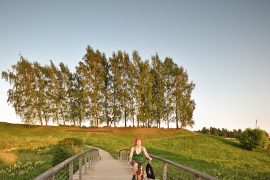I am not a particularly athletic or physically active person. If given a choice between a hike through the woods or a book and a hammock, the good read always wins out. I start and stop exercise routines at least once a year — usually more. But I do have a bicycle, and once a year, I sit atop that tiny seat and pedal my way through 14 miles of parks in Baltimore.
That was yesterday, and today I’m paying for it, big time. Not only do I have a funny-shaped sunburn on my back (from the one cool exercise shirt that I have), but my legs and feet and rear end are screaming: “What the hell??” Still, I know I’ll do this next year, too. Because it’s the one time a year that it’s worth hoisting three bikes on top of our car and driving 15 minutes away to explore the city parks.
Of course, I think about the math involved. Between birdwatching and listening to my almost 12-year-old complaining, what else is there to do? Here’s what I came up with.
1. I woke up yesterday morning with one thing on my mind: I do not want to spend all day on a bike. But would it be all day? Not likely. So I went to the interwebs to help me estimate the time I’d actually be cycling. Here’s what I found:
For the kind of biking I was about to do, an average speed is about 10 miles per hour. I didn’t even bother with a formula; this information was enough to help me estimate that I’d be pedaling for about 90 minutes or so. (I figured I’m slower than average, we’d have one 5-minute break, and we were biking 14 miles, not 10.)
How did I do with my estimate? Not bad. We pushed off at 9:00 a.m. and were munching hamburgers and hotdogs by 11:45 or so.
2. I once thought that the pedals and brakes and chain were the most important parts of the bike. But it turns out that the seat height has more to do with a comfortable ride than most anything else.
Last year, I spent the first half of the course on a seat that was way, way too low. My thighs were burning by the time we hit the rest spot. Luckily, there was a bike tech there who showed me how to adjust my seat and where. I thought I would fall off the precipitous height when he was done, but the rest of the ride was a breeze, comparatively speaking.
Here’s how it works: The leverage of your pedaling is controlled by the seat height. If your seat is too low, you’ll work way, way too hard to get up even the most modest hill. In other words, when your seat is adjusted properly, you’ll get the most efficient pedal stroke. (And your rectus femoris muscle will thank you.)
There are formulas and online calculators that can help you figure this out. But as a once-a-year biker, I rely on a simple idea. When sitting on my bike, I position my feet at 12:00 and 6:00. If my leg is completely extended in the 6:00 position, my seat is at the correct height.
There’s tons more math in cycling, I’m sure. But as a novice, these little calculations and estimates are enough for me. By next year, I’ll forget how sore I am today — and the trouble it is to get our bikes into the rack — and hit these trails again.
Are you a cycler? What math have you used to help keep your pedaling efficient or manage your rides? Share your ideas in the comments section.
Wait! Isn’t it Monday? Where is Math at Work Monday? It’ll be back, I promise. I had some scheduling problems with some sources, so you may see an interview later this week. Don’t worry!
